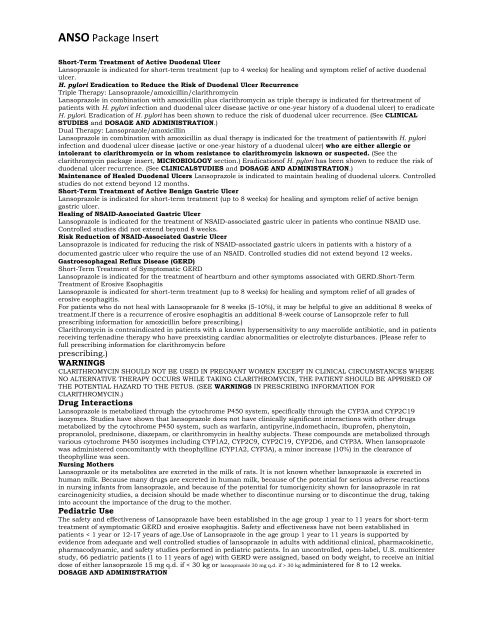ANSO Package Insert - Shaigan
ANSO Package Insert - Shaigan
ANSO Package Insert - Shaigan
You also want an ePaper? Increase the reach of your titles
YUMPU automatically turns print PDFs into web optimized ePapers that Google loves.
<strong>ANSO</strong> <strong>Package</strong> <strong>Insert</strong><br />
Short-Term Treatment of Active Duodenal Ulcer<br />
Lansoprazole is indicated for short-term treatment (up to 4 weeks) for healing and symptom relief of active duodenal<br />
ulcer.<br />
H. pylori Eradication to Reduce the Risk of Duodenal Ulcer Recurrence<br />
Triple Therapy: Lansoprazole/amoxicillin/clarithromycin<br />
Lansoprazole in combination with amoxicillin plus clarithromycin as triple therapy is indicated for thetreatment of<br />
patients with H. pylori infection and duodenal ulcer disease (active or one-year history of a duodenal ulcer) to eradicate<br />
H. pylori. Eradication of H. pylori has been shown to reduce the risk of duodenal ulcer recurrence. (See CLINICAL<br />
STUDIES and DOSAGE AND ADMINISTRATION.)<br />
Dual Therapy: Lansoprazole/amoxicillin<br />
Lansoprazole in combination with amoxicillin as dual therapy is indicated for the treatment of patientswith H. pylori<br />
infection and duodenal ulcer disease (active or one-year history of a duodenal ulcer) who are either allergic or<br />
intolerant to clarithromycin or in whom resistance to clarithromycin isknown or suspected. (See the<br />
clarithromycin package insert, MICROBIOLOGY section.) Eradicationof H. pylori has been shown to reduce the risk of<br />
duodenal ulcer recurrence. (See CLINICALSTUDIES and DOSAGE AND ADMINISTRATION.)<br />
Maintenance of Healed Duodenal Ulcers Lansoprazole is indicated to maintain healing of duodenal ulcers. Controlled<br />
studies do not extend beyond 12 months.<br />
Short-Term Treatment of Active Benign Gastric Ulcer<br />
Lansoprazole is indicated for short-term treatment (up to 8 weeks) for healing and symptom relief of active benign<br />
gastric ulcer.<br />
Healing of NSAID-Associated Gastric Ulcer<br />
Lansoprazole is indicated for the treatment of NSAID-associated gastric ulcer in patients who continue NSAID use.<br />
Controlled studies did not extend beyond 8 weeks.<br />
Risk Reduction of NSAID-Associated Gastric Ulcer<br />
Lansoprazole is indicated for reducing the risk of NSAID-associated gastric ulcers in patients with a history of a<br />
documented gastric ulcer who require the use of an NSAID. Controlled studies did not extend beyond 12 weeks.<br />
Gastroesophageal Reflux Disease (GERD)<br />
Short-Term Treatment of Symptomatic GERD<br />
Lansoprazole is indicated for the treatment of heartburn and other symptoms associated with GERD.Short-Term<br />
Treatment of Erosive Esophagitis<br />
Lansoprazole is indicated for short-term treatment (up to 8 weeks) for healing and symptom relief of all grades of<br />
erosive esophagitis.<br />
For patients who do not heal with Lansoprazole for 8 weeks (5-10%), it may be helpful to give an additional 8 weeks of<br />
treatment.If there is a recurrence of erosive esophagitis an additional 8-week course of Lansoprzole refer to full<br />
prescribing information for amoxicillin before prescribing.)<br />
Clarithromycin is contraindicated in patients with a known hypersensitivity to any macrolide antibiotic, and in patients<br />
receiving terfenadine therapy who have preexisting cardiac abnormalities or electrolyte disturbances. (Please refer to<br />
full prescribing information for clarithromycin before<br />
prescribing.)<br />
WARNINGS<br />
CLARITHROMYCIN SHOULD NOT BE USED IN PREGNANT WOMEN EXCEPT IN CLINICAL CIRCUMSTANCES WHERE<br />
NO ALTERNATIVE THERAPY OCCURS WHILE TAKING CLARITHROMYCIN, THE PATIENT SHOULD BE APPRISED OF<br />
THE POTENTIAL HAZARD TO THE FETUS. (SEE WARNINGS IN PRESCRIBING INFORMATION FOR<br />
CLARITHROMYCIN.)<br />
Drug Interactions<br />
Lansoprazole is metabolized through the cytochrome P450 system, specifically through the CYP3A and CYP2C19<br />
isozymes. Studies have shown that lansoprazole does not have clinically significant interactions with other drugs<br />
metabolized by the cytochrome P450 system, such as warfarin, antipyrine,indomethacin, ibuprofen, phenytoin,<br />
propranolol, prednisone, diazepam, or clarithromycin in healthy subjects. These compounds are metabolized through<br />
various cytochrome P450 isozymes including CYP1A2, CYP2C9, CYP2C19, CYP2D6, and CYP3A. When lansoprazole<br />
was administered concomitantly with theophylline (CYP1A2, CYP3A), a minor increase (10%) in the clearance of<br />
theophylline was seen.<br />
Nursing Mothers<br />
Lansoprazole or its metabolites are excreted in the milk of rats. It is not known whether lansoprazole is excreted in<br />
human milk. Because many drugs are excreted in human milk, because of the potential for serious adverse reactions<br />
in nursing infants from lansoprazole, and because of the potential for tumorigenicity shown for lansoprazole in rat<br />
carcinogenicity studies, a decision should be made whether to discontinue nursing or to discontinue the drug, taking<br />
into account the importance of the drug to the mother.<br />
Pediatric Use<br />
The safety and effectiveness of Lansoprazole have been established in the age group 1 year to 11 years for short-term<br />
treatment of symptomatic GERD and erosive esophagitis. Safety and effectiveness have not been established in<br />
patients < 1 year or 12-17 years of age.Use of Lansoprazole in the age group 1 year to 11 years is supported by<br />
evidence from adequate and well controlled studies of lansoprazole in adults with additional clinical, pharmacokinetic,<br />
pharmacodynamic, and safety studies performed in pediatric patients. In an uncontrolled, open-label, U.S. multicenter<br />
study, 66 pediatric patients (1 to 11 years of age) with GERD were assigned, based on body weight, to receive an initial<br />
dose of either lansoprazole 15 mg q.d. if < 30 kg or lansoprazole 30 mg q.d. if > 30 kg administered for 8 to 12 weeks.<br />
DOSAGE AND ADMINISTRATION


